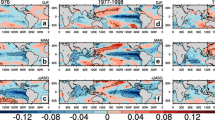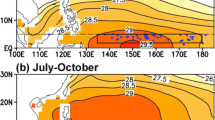Abstract
The role of the 50- to 200-hPa zonal wind shear in modulating tropical cyclone (TC) genesis over the western North Pacific (WNP) in May is investigated in this study. Concurrent with the strong cross-tropopause shear over the key region (0°–5°N, 160°–180°E), suppressed convection was observed over the tropical WNP, especially over the South China Sea and the Philippines. The monsoon trough (MT) was confined westward. However, enhanced convection occurred in the weak shear years and the MT extended eastward. This cross-tropopause wind shear is negatively correlated with TC genesis in May, with a decreased (increased) number of TCs corresponding to strong (weak) cross-tropopause wind shear.
This cross-tropopause wind shear can be treated as the combined impacts of the El Niño-Southern Oscillation (ENSO) events and the stratospheric quasi-biennial oscillation (QBO). When decaying El Niño events coupled with the easterly phase of the QBO were noted, the cross-tropopause wind shear was stronger with weakened convection, and an enhanced western Pacific subtropical high was observed. TCs are rarely generated during these years. In contrast, the modulation of the QBO westerly phase on decaying La Niña events is limited. Affected by the QBO westerly phase, TC genesis in the May following La Niña events is only slightly enhanced. The energy analysis indicates that the combined impacts of the decaying El Niño events and the QBO easterly phase might suppress the barotropic eddy kinetic energy conversion in May, whereas the decaying La Niña events and the QBO west phase act in an opposite manner.










Similar content being viewed by others
References
Baldwin MP et al (2001) The quasi-biennial oscillation. Rev Geophys 39:179–229
Camargo SJ, Sobel AH (2010) Revisiting the influence of the quasi-biennial oscillation on tropical cyclone activity. J Clim 23:5810–5825
Caron L-P, Boudreault M, Camargo SJ (2015) On the variability and predictability of eastern Pacific tropical cyclone activity. J Clim 28:9678–9696
Chan JCL (1995) Tropical cyclone activity in the western north Pacific in relation to the stratospheric quasi-biennial oscillation. Mon Weather Rev 123:2567–2571
Chen T-C, Weng SP, Yamazaki N, Kiehne S (1998) Interannual variation in the tropical cyclone formation over the Western North Pacific. Mon Weather Rev 126:1080–1090
Chen T-C, Tsay J-D, Matsumoto J, Alpert J (2017) Impact of the summer monsoon westerlies on the South China Sea tropical cyclone genesis in may. Weather Forecast 32:925–947
Clark JD, Chu PS (2002) Interannual variation of tropical cyclone activity over the central north pacific. J Meteorol Soc Jpn 80:403–418
Collimore CC, Martin DW, Hitchman MH, Huesmann A, Waliser DE (2003) On the relationship between the QBO and tropical deep convection. J Clim 16:2552–2568
Du Y, Yang L, Xie S-P (2011) Tropical Indian ocean influence on northwest Pacific tropical cyclones in summer following strong El Niño. J Clim 24:315–322
Fadnavis S, Ernest Raj P, Buchunde P, Goswami BN (2014) In search of influence of stratospheric Quasi-Biennial Oscillation on tropical cyclones tracks over the Bay of Bengal region. Int J Climatol 34:567–580
Feng J, Chen W, Tam CY, Zhou W (2011) Different impacts of El Ni o and El Ni o Modoki on China rainfall in the decaying phases. Int J Climatol 31:2091–2101
Feng T, Chen G-H, Huang R-H, Shen X-Y (2014) Large-scale circulation patterns favourable to tropical cyclogenesis over the western North Pacific and associated barotropic energy conversions. Int J Climatol 34:216–227
Goebbert KH, Leslie LM (2010) Interannual variability of northwest Australian tropical cyclones. J Clim 23:4538–4555
Gray WM (1984) Atlantic seasonal hurricane frequency. Part I: El Niño and 30 mb quasi-biennial oscillation influences. Mon Weather Rev 112:1649–1668
Gray WM, Sheaffer JD, Knaff JA (1992) Influence of the stratospheric QBO on ENSO variability. J Meteorol Soc Jpn 70:975–995
He H, Yang J, Gong D, Mao R, Wang Y, Gao M (2015) Decadal changes in tropical cyclone activity over the western North Pacific in the late 1990s. Clim Dyn 45:3317–3329
Ho C-H, Kim H-S, Jeong J-H, Son S-W (2009) Influence of stratospheric quasi-biennial oscillation on tropical cyclone tracks in the western North Pacific. Geophys Res Lett 36:L06702. https://doi.org/10.1029/2009gl037163
Huangfu J, Huang R, Chen W (2015) Influence of tropical western Pacific warm pool thermal state on the interdecadal change of the onset of the South China Sea summer monsoon in the late-1990s. Atmos Oceanic Sci Lett 8:95–99
Huangfu J, Huang R, Chen W (2017a) Interdecadal increase of tropical cyclone genesis frequency over the western north Pacific in May. Int J Climatol 37:1127–1130
Huangfu J, Huang R, Chen W (2017b) Relationship between the South China Sea summer monsoon onset and tropical cyclone genesis over the western North Pacific. Int J Climatol 37:5206–5210
Huangfu J, Chen W, Ma T, Huang R (2017c) Influences of sea surface temperature in the tropical Pacific and Indian Oceans on tropical cyclone genesis over the western North Pacific in May. Clim Dyn. https://doi.org/10.1007/s00382-017-3989-y
Jury MR, Pathack B, Parker B (1999) Climatic determinants and statistical prediction of tropical cyclone days in the southwest Indian ocean. J Clim 12:1738–1746
Knapp KR, Kruk MC, Levinson DH, Diamond HJ, Neumann CJ (2010) The international best track archive for climate stewardship (IBTrACS) unifying tropical cyclone data. Bull Am Meteorol Soc 91:363–376
Lander MA (1994) An exploratory analysis of the relationship between tropical storm formation in the western north Pacific and ENSO. Mon Weather Rev 122:636–651
Liebmann BCAS (1996) Description of a complete (interpolated) outgoing longwave radiation dataset. Bull Am Meteorol Soc 77:1275–1277
Liu KS, Chan JC (2013) Inactive period of western North Pacific tropical cyclone activity in 1998–2011. J Clim 26:2614–2630
Maloney ED, Hartmann DL (2001) The Madden–Julian oscillation, barotropic dynamics, and north Pacific tropical cyclone formation. Part I: observations. J Atmos Sci 58:2545–2558
Rayner N et al. (2003) Global analyses of sea surface temperature, sea ice, and night marine air temperature since the late nineteenth century. J Geophys Res Atmos (1984–2012) 108:D14,4407. https://doi.org/10.1029/2002JD002670
Shapiro LJ (1989) The relationship of the quasi-biennial oscillation to Atlantic tropical storm activity. Mon Weather Rev 117:1545–1552
Simmons A, Uppala S, Dee D, Kobayashi S (2007) ERA-Interim: new ECMWF reanalysis products from 1989 onwards. ECMWF newsletter 110:25–35
Wu L, Wen Z, Wu R (2015) Influence of the monsoon trough on westward-propagating tropical waves over the western north Pacific. Part II: energetics and numerical experiments. J Clim 28:9332–9349
Wu L, Zhang H, Chen J-M, Feng T (2018) Impact of two types of El Nino on tropical cyclones over the western north Pacific: sensitivity to location and intensity of pacific warming. J Clim 31:1725–1742
Xie S-P, Hu K, Hafner J, Tokinaga H, Du Y, Huang G, Sampe T (2009) Indian ocean capacitor effect on Indo–Western Pacific climate during the summer following El Niño. J Clim 22:730–747
Acknowledgements
This work was supported by the National Key Research and Development Program of China (2016YFA0600603), and the National Natural Science Foundation of China (Grant nos. 41705071, 41661144016, 41461164005, 41375065, 41230527).
Author information
Authors and Affiliations
Corresponding author
Rights and permissions
About this article
Cite this article
Huangfu, J., Chen, W., Jian, M. et al. Impact of the cross-tropopause wind shear on tropical cyclone genesis over the Western North Pacific in May. Clim Dyn 52, 3845–3855 (2019). https://doi.org/10.1007/s00382-018-4363-4
Received:
Accepted:
Published:
Issue Date:
DOI: https://doi.org/10.1007/s00382-018-4363-4




